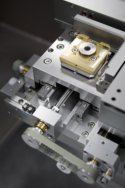The Different Types of Microscopes
Exploring the Top Four and More
There are several different types of microscopes used in light microscopy, and the four most popular types are Compound, Stereo, Digital and the Pocket or handheld microscopes.
Some types are best suited for biological applications, where others are best for classroom or personal hobby use.
Outside of light microscopy are the exciting developments with electron microscopes and in scanning probe microscopy.
Below is a brief introduction of the different types available.
For further information and guidance in your search and to find microscope reviews please continue reading about each type by following the corresponding links.
The Compound Light Microscope
Commonly binocular (two eyepieces), the compound light microscope, combines the power of lenses and light to enlarge the subject being viewed.
Typically, the eyepiece itself allows for 10X or 15X magnification and when combined with the three or four objective lenses, which can be rotated into the field of view, produce higher magnification to a maximum of around 1000X generally.
The compound light microscope is popular among botanists for studying plant cells, in biology to view bacteria and parasites as well as a variety of human/animal cells.

It is a useful microscope in forensic labs for identifying drug structures.
Compound light microscopes are one of the most familiar of the different types of microscopes as they are most often found in science and biology classrooms.
For this reason, simple models are readily available and are inexpensive.
As well, several microscopy imaging techniques benefit scientists and researchers using the compound microscope and are worth exploring.
Click here to read about the compound light microscope in greater detail
The Stereo Microscope
The Stereo microscope, also called a dissecting microscope, has two optical paths at slightly different angles allowing the image to be viewed three-dimensionally under the lenses.
Stereo microscopes magnify at low power, typically between 10X and 200X, generally below 100x.
With this type of microscope you generally have the choice of purchasing the fixed or zoom variety from a manufacturer and are relatively inexpensive.
Uses for this type of microscope include looking at surfaces, microsurgery, and watch making, plus building and inspecting circuit boards.
Stereo microscopes allow students to observe plant photosynthesis in action.
Click here to read more about the stereo microscope.
The Digital Microscope
Step into the 21st century with a digital microscope and enter a world of amazing detail.
The digital microscope, invented in Japan in 1986, uses the power of the computer to view objects not visible to the naked eye.
Among the different types of microscopes, this kind can be found with or without eyepieces to peer into.
It connects to a computer monitor via a USB cable, much like connecting a printer or mouse. The computer software allows the monitor to display the magnified specimen. Moving images can be recorded or single images captured in the computer’s memory.
An advantage of digital microscopes is the ability to email images, as well as comfortably watch moving images for long periods.
The popularity of the digital microscope has increased at schools and among hobbyists.
Click here to read about the digital microscope in more detail.
The USB Computer Microscope
Although not well suited to the same scientific applications as other light microscopes, the USB Computer microscope, among the different types of microscopes, can be used on almost any object and requires no preparation of the specimen.
It is essentially a macro lens used to examine images on a computer screen plugged into its USB port.
However, the magnification is restricted and is not comparable to your standard compound light microscope at only up to 200X with a relatively small depth of field.
Great for hobbyists and kids, it is an inexpensive device with a purchase price usually under $200US.
To read more on the USB Computer Microscope click here
The Pocket Microscope
In examining the different types of microscopes available on the market, the pocket microscope may be tiny but its abilities are impressive.
This is a device which is a great gift for a child or your student. It is used by scientists for hand-held imaging of a variety of specimens/objects in the field or in the laboratory.
It is small, durable and portable with a magnification ranging from 25x to 100x. There are many different models available.
You may even want to check out the portable digital microscopes that are available now as this is an invaluable tool to aid in image sharing and analysis.
To read more about the different pocket microscopes available click here
The Electron Microscope
Among the different types of microscopes, the Electron Microscope(EM) is a powerful microscope available and used today, allowing researchers to view a specimen at nanometer size.
The transmission electron microscope(TEM), the first type of EM, is capable of producing images 1 nanometer in size.
The TEM is a popular choice for nanotechnology as well as semiconductor analysis and production.

A second type of electron microscope is the scanning electron microscope(SEM)are approximately 10 times less powerful than TEMs, they produce high-resolution, sharp, black and white 3D images.
The Transmission Electron Microscopes and Scanning Electron Microscopes have practical applications in such fields as biology, chemistry, gemology, metallurgy and industry as well as provide information on the topography, morphology, composition and crystallographic data of samples.
To better understand the Electron Microscope click here.
The Scanning Probe Microscope (SPM)
Among the different types of microscopes and microscopy techniques, scanning probe microscopy is used today in academic and industrial settings for those sectors involving physics, biology and chemistry. These instruments are used in research and development as standard analysis tools.
Images are highly magnified and are observed as three-dimensional-shaped-specimens in real time. SPMs employ a delicate probe to scan the surface of the specimen eliminating the limitations that are found in electron and light microscopy.
For further information about the Scanning Probe Microscope
The Acoustic Microscope
The Acoustic Microscope is less about resolution and more about finding faults, cracks or errors from samples during the manufacturing process.
With the use of high ultrasound, this type of microscope is the easiest intra-cavity imaging tool available. It is a microscope that is under used primarily due to the fact that it is less known for its capabilities.
Scanning acoustic microscopy, or SAM, is the most current type of acoustic microscopy available to today's scientists. They can use it to view a sample internally without staining it or causing it any damage thanks to point focusing technology, which relies on a beam to scan and penetrate the specimen while it is in water.
Explore the benefits, limitations and uses of the Acoustic Microscope.
See Also:
History of the Microscope; Microscopy Applications and Experiments.
Return from Different Types of Microscopes to Best Microscope Home
Find out how to advertise on MicroscopeMaster!








